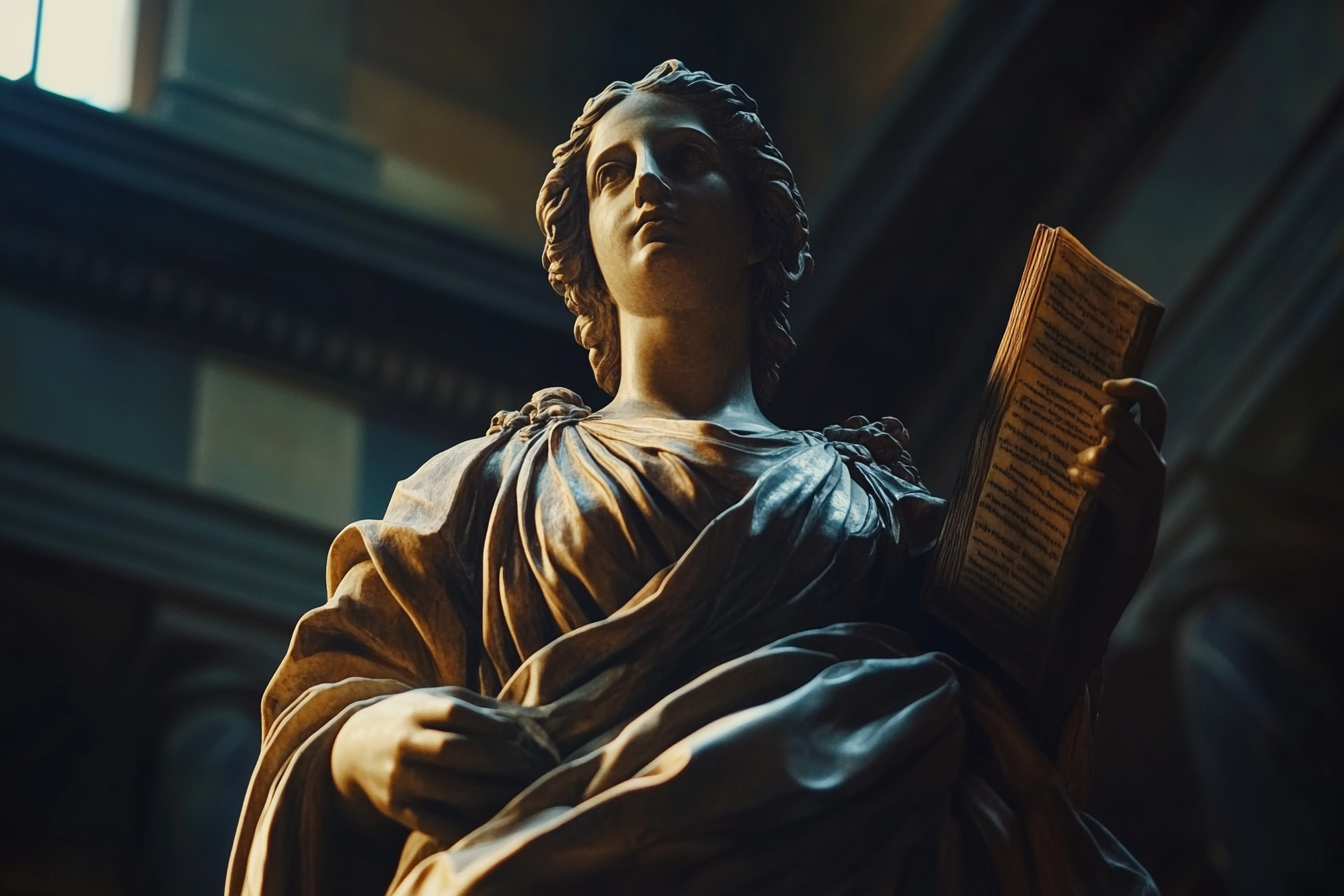
The Enlightenment was a time of significant change in Europe, lasting from the late 1600s to the early 1800s.
During this period, there was a strong shift toward rational thinking and the use of evidence, moving away from the superstition and strict religious beliefs that were common during the Middle Ages.
This intellectual movement had a big impact on the arts, giving rise to Enlightenment art, which emphasized clarity, order, and reason.
This era of art laid the foundation for styles like Neoclassicism and Romanticism and continues to influence artists even today.
Key Characteristics of Enlightenment Art
Enlightenment art is known for reflecting the key ideals of the time, including a focus on rationalism, classicism, humanism, and a spirit of skepticism and critique.
Rationalism and classicism
One of the main ideas of the Enlightenment was rationalism, which emphasized the importance of reason and logic.
This was reflected in the art of the period, which often featured clear lines, well-structured compositions, and balanced proportions.
Classicism, inspired by the art and culture of ancient Greece and Rome, also played a major role.
Artists looked to these classical influences for inspiration, aiming to capture the simplicity, harmony, and refined elegance that were seen as the epitome of order and rationality.
- Read also: Enlightening the World: The Lasting Impact of the Age of Enlightenment
- Read also: Breaking Barriers: 9 Women Philosophers in the Enlightenment Era
Humanism
Humanism, which values the worth and potential of individuals, was another key theme during the Enlightenment.
Art from this period often celebrated human achievements, intellect, and beauty, focusing on the idea that people have the power to progress and improve.
Portraits of important figures like scientists, philosophers, and political leaders were especially popular, as they highlighted the contributions of these individuals to society and promoted the idea of human greatness.
Skepticism and critique
The Enlightenment was also characterized by a spirit of skepticism and critique, with many people challenging traditional authority and questioning established norms.
This critical approach was evident in the art of the time, which frequently included elements of satire and social commentary.
Artists used their work to critique society, politics, and religion, encouraging people to think critically and question the status quo.

Representative Artists and Works
Several artists emerged as prominent figures during the Enlightenment period, creating works that exemplified the ideals of the era.
Here are some key artists and their notable works:
Jacques-Louis David
Jacques-Louis David was one of the most influential artists of the Enlightenment, known for his strong adherence to classical ideals and his ability to convey political and moral messages through his art.
Oath of the Horatii (1784)
This painting is a quintessential example of Enlightenment art, depicting a story from Roman history that emphasizes duty, sacrifice, and patriotism.
The composition’s clear lines and structured form reflect the rationalism of the period.
The Death of Marat (1793)
This powerful work depicts the murdered revolutionary leader Jean-Paul Marat, presenting him as a martyr for the cause of liberty.
The painting’s stark realism and emotional intensity highlight the Enlightenment’s emphasis on humanism and political critique.
The Death of Socrates (1787)
In this work, David portrays the Greek philosopher Socrates willingly accepting his death sentence, a powerful image of stoic virtue and commitment to one’s principles.
The painting’s classical composition and moral message align with Enlightenment ideals.
The Coronation of Napoleon (1807)
This grandiose painting captures the coronation ceremony of Napoleon Bonaparte, reflecting both the grandeur of the event and the complex political landscape of the time.
David’s meticulous attention to detail and balanced composition showcase the Enlightenment’s emphasis on clarity and order.
Thomas Jefferson
While primarily known as an American statesman and the principal author of the Declaration of Independence,
Thomas Jefferson was also an accomplished architect influenced by Enlightenment ideals.
Monticello (1768-1809)
Jefferson’s home in Virginia, Monticello, is a masterpiece of Enlightenment architecture, blending classical elements with innovative design.
The building’s symmetry, proportion, and use of classical motifs reflect Jefferson’s commitment to rationalism and his belief in the transformative power of architecture.
Benjamin West
Benjamin West was an American painter who became one of the leading artists in England during the Enlightenment.
He is known for his historical paintings that combined realism with dramatic storytelling.
The Death of General Wolfe (1770)
This painting depicts the death of British General James Wolfe during the Battle of Quebec in 1759.
West’s use of contemporary dress, rather than classical or allegorical attire, was revolutionary, emphasizing the Enlightenment’s focus on realism and historical accuracy.
Jean-Honoré Fragonard
Jean-Honoré Fragonard was a French painter associated with the Rococo style, which, while often seen as a reaction against the austerity of Enlightenment classicism, still engaged with the period’s themes in its own way.
The Swing (1767)
This iconic Rococo painting is known for its playful, light-hearted depiction of romance and flirtation.
Although it contrasts with the rationalism and moral seriousness of much Enlightenment art, “The Swing” reflects the period’s fascination with human emotion and the complexities of social relationships.

Themes and Subjects
Enlightenment art explored a wide range of themes and subjects, often reflecting the intellectual and social currents of the time.
Historical events
Many artworks from the Enlightenment period depicted important historical events, such as revolutions, wars, and the lives of key political figures.
These pieces often carried moral messages or celebrated ideals like liberty, equality, and justice, reflecting the Enlightenment’s focus on progress and reform.
Mythology and allegory
Classical mythology and allegory were also popular in Enlightenment art.
These subjects allowed artists to explore timeless themes and share moral lessons through their work.
Often, they reinterpreted ancient stories in ways that resonated with contemporary ideas, blending tradition with new perspectives.
Social and political commentary
Enlightenment art often included social and political commentary, using satire and critique to challenge existing norms and encourage people to think critically.
This approach was in line with the period’s commitment to questioning authority and promoting individual freedom.
Portraiture
Portraits were a major focus during the Enlightenment, highlighting the era’s emphasis on humanism and individual achievement.
Portraits of influential people, such as scientists, philosophers, and political leaders, were especially popular.
These artworks celebrated the contributions of these figures to society and reinforced the Enlightenment’s belief in the potential for human progress.

Impact of Enlightenment Art
The Enlightenment had a deep and lasting impact on Western art, shaping future art movements and leaving a significant legacy in modern culture.
Influence on subsequent art movements
Enlightenment art paved the way for two major 19th-century art movements: Romanticism and Neoclassicism.
Romanticism focused on emotion, imagination, and the awe-inspiring aspects of nature, while Neoclassicism carried forward the Enlightenment’s emphasis on order, clarity, and rationality.
Neoclassicist artists drew heavily from classical art and culture, continuing the tradition of structured and balanced compositions inspired by ancient Greece and Rome.
Legacy in modern art
The values of the Enlightenment, such as reason, logic, and humanism, continue to influence modern art and culture.
Many contemporary artists and thinkers draw on these Enlightenment ideals, exploring themes of progress, individualism, and the power of human reason in their work.
This ongoing influence shows how the Enlightenment’s ideas are still relevant and inspiring today.
Contributions to western culture and society
The impact of the Enlightenment goes beyond art, deeply influencing Western culture and society.
The period’s promotion of individual liberty, equality, and progress has shaped the development of modern democratic institutions and inspired social and political reforms around the world.
The ideas born during the Enlightenment continue to be a foundation for movements that seek to advance human rights and improve society.

- Read also: Intellectual Brilliance: 7 Scottish Enlightenment Thinkers
- Read also: From Reason to Revelation: Enlightenment Impact on Religion
Final Thoughts
The Enlightenment was a period of profound intellectual and artistic change that transformed the way people thought about the world and their place in it.
Enlightenment art, with its emphasis on reason, humanism, and critique, played a crucial role in shaping the cultural and intellectual landscape of the time.
Its legacy continues to resonate today, reminding us of the enduring power of art to inspire, challenge, and transform.



